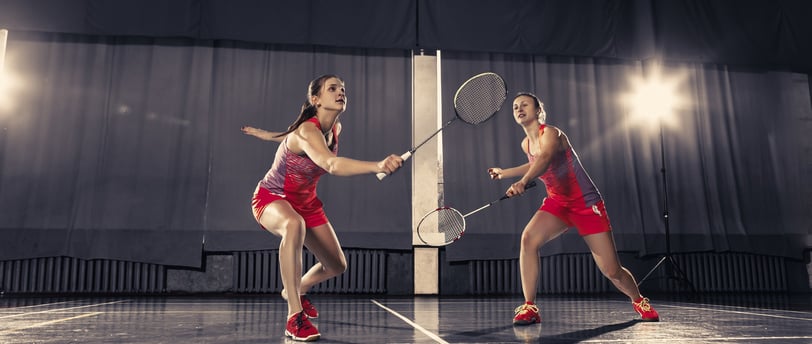Read football & basketball articles and other sports only at Finessekick.com
The Psychology Behind Victory: How Badminton Athletes Manage Pressure on the Court
Badminton requires not only physical strength and technical agility but also strong mental endurance. For an athlete, the ability to manage pressure is a determining factor in winning or losing on the court. So, how do badminton athletes, especially those who excel at the world level, handle pressure during critical moments and stay focused amid great challenges? This article explores the psychological strategies employed by badminton athletes to manage pressure and maintain optimal performance.
BADMINTON
A. Sahrul Romadhon
11/2/20243 min read


1. Visualization Techniques and Goal Setting
One common method used by badminton athletes is visualization. This technique involves imagining oneself playing well, hitting perfect shots, and scoring crucial points. Visualization helps athletes build confidence and mental readiness. Before a match, an athlete might visualize the ideal flow of the game they want to achieve. According to sports psychology studies, visualization can enhance performance by creating positive thought patterns that help reduce fear or doubt on the court.
Additionally, goal setting plays a crucial role. Instead of focusing on the final outcome, such as winning or losing, many athletes concentrate on process goals, like improving their smash technique or reducing service errors. This helps them stay motivated without feeling burdened by the final result, which may not always meet expectations.
2. Managing Stress and Pressure through Breathing Techniques
When facing critical moments, such as close scores or tough opponents, athletes often experience adrenaline spikes that can trigger anxiety and tension. One technique used to alleviate stress is deep breathing. In this technique, athletes take deep breaths, hold them briefly, and then exhale slowly. This helps calm the heart rate, lower cortisol levels (the stress hormone), and keep the mind focused.
Applying breathing techniques not only eases tension but also helps combat mental fatigue, especially during long matches. With a calmer mind, athletes can concentrate better on game strategies rather than external factors like audience reactions or the pressure to win.
3. Building a Competitive Mentality through Mental Rehearsal
Some athletes also use mental rehearsal regularly. This means training the brain to face difficult situations psychologically, just as they practice their shots on the court. Consistent mental rehearsal helps athletes develop a competitive mentality, often referred to as killer instinct, which is the instinct to stay calm and make the best decisions under pressure. Usually, this training is guided by a sports psychologist who equips athletes with various challenging scenarios, such as trailing in score or facing a superior opponent.
Athletes accustomed to mental rehearsal generally recover faster when trailing in points or making mistakes. They tend to be mentally tougher and can bounce back even from unfavorable positions. Thus, mental rehearsal also plays a role in developing a positive mindset or growth mindset, the belief that every challenge is an opportunity to learn and grow.
4. Detachment from Match Outcomes
One of the best ways to handle pressure on the court is by detaching from match outcomes. This means that an athlete needs to remember that their self-worth is not determined by the match result. Although it seems simple, this approach is often difficult to apply due to demands and expectations from coaches, spectators, and even themselves. Many top athletes, like Viktor Axelsen and Carolina Marin, use this method to stay focused on the playing process rather than the final outcome.
According to sports psychologists, this detachment attitude can help athletes avoid frustration or pressure from overly high targets. Thus, athletes can better control their emotions and think clearly when facing challenges.
5. Building Strong Social Support
Lastly, social support from coaches, family, friends, or even fellow athletes plays a crucial role in managing pressure. Social support can be a strong source of motivation and provide a sense of security for athletes. They know that both victories and defeats will still be accepted and supported by those around them.
Research shows that athletes with good social support networks tend to have higher mental resilience. They feel less alone in facing pressure and can remain calm knowing there are people who always support them. This also helps boost confidence and reduce the risk of excessive anxiety or stress.
Conclusion
The ability of badminton athletes to manage pressure on the court is not an innate skill but something they train and build over time. By using visualization techniques, breathing exercises, mental rehearsal, detachment attitudes, and social support, athletes can develop the mental resilience needed to face challenges on the court. Managing pressure does not mean eliminating it but rather controlling emotions and thoughts so they do not negatively affect performance. Ultimately, the ability to manage pressure is key for athletes to achieve victory after victory and reach the pinnacle of success.
I hope this article provides insight for badminton enthusiasts and those who want to understand the psychological aspects of the game more deeply.
FinesseKick.com
Discover the latest articles about the world of sports.
Know More
Contact
© 2024. All rights reserved.
